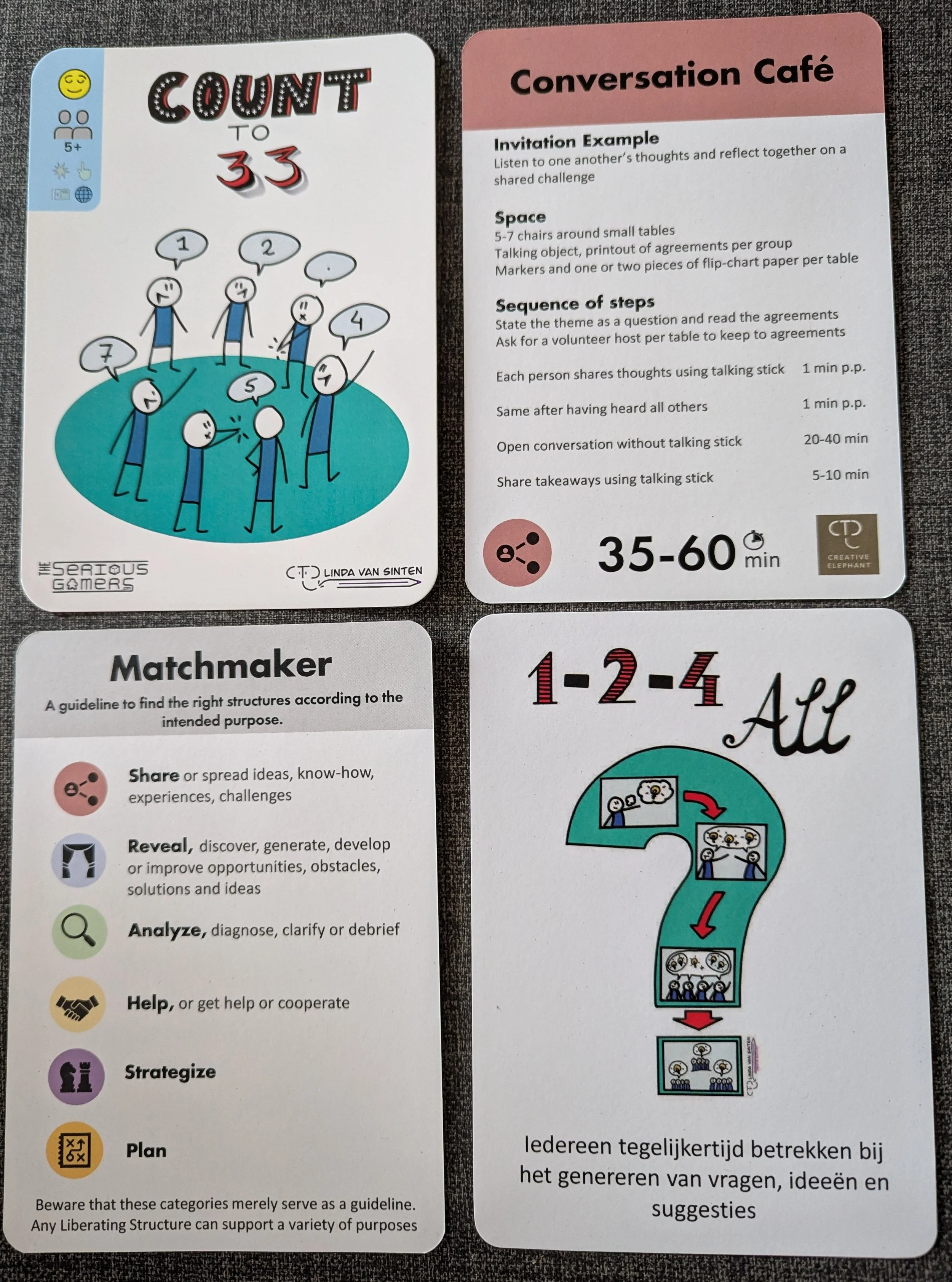How to design
a good meeting or workshop
Designing the flow of a meeting or workshop
There are many factors to consider when designing a meeting, workshop, training or event. The focus of this page is on designing the flow of activities, and it is aimed at beginner to intermediate level facilitators. The building blocks that we use here are Liberating Structures. However, the high-level approach presented here also works for other building blocks like a presentation, brainstorm, energizers, Metaplan techniques, etc.
Two use cases
The suggestions here are for two distinct use cases:
Designing a sequence of steps
Selecting 1 suitable Liberating Structure
Have a different question?
If this doesn’t answer your question, feel free to contact us!
Designing a sequence of steps
The following steps are a generic approach for designing a meeting, workshop, training or event. We’ll call it a session.
Decide on the purpose of your session.
Knowing what you want to achieve is a crucial first step. In addition, you need to know roughly how many people will participate, and how much time you’ve got. A 1 hour meeting with 8 is very different than a 2 day workshop for 50 people, even if the purpose is similar.
Make a quick selection of potentially useful building blocks.
There are many Liberating Structures, LS in Development, Primers, Energizers, Serious Games and other formats that can be used as building blocks for a session. What we’re doing here is just a first filter. Don’t worry if you end up with 10 or more building blocks.
If you’re okay with using primarily Liberating Structures, I suggest you use the LS Matchmaker for this. Below are instructions how to use the LS Matchmaker.Browse the selected building blocks and remove the least promising ones.
If you read the description of a building block, you’ll get a better idea if it fits with your session purpose. Some may be too long, others may be too playful for your audience, and yet others may be okay but you’ve seen another building block that appeals more.
You’re trying to get a shortlist of building blocks that you’ll use to design one or more alternative sequences.I love to use physical cards with descriptions of the building blocks. For me, cards with a visualisation work best. For example, the LS Visual Design Cards (available in English and Dutch), or the Energizer Deck.
Create one or more sequences of building blocks.
If you’re using physical cards that describe the building blocks, start arranging them on a table or on the floor. How does the output of one building block feed into the next? Which building blocks do something similar, and which of those works best for you?
Select 1 sequence and use that to design a first version of your session.
Now is the time to start crafting invitations/prompts, to consider riffs and variations, add breaks, list materials you’ll need etc.
Refine and improve
Your first draft is rarely perfect. If you can, discuss it with a co-facilitator or other colleague. Refine, reflect, and improve.
How to use the LS Matchmaker
There are a few different versions of the LS Matchmaker available. The instructions here work with the English and Dutch versions that you can download for free om this page. There are 2 other versions that I am aware of, which work similarly but slightly differently:
The original LS Matchmaker and Matching Matrix created by Keith McCandless and Henri Lipmanowicz. Disadvantage: the pages don’t line up so it is a bit harder to check the results.
A variation by Carsten Lützen which is very similar to the one used here, but works double-sided and without a plastic sleeve. You can download it here. Advantage: you don’t need a plastic sleeve. Disadvantage: the paper can’t be re-used. Also check out his excellent website for more information on LS!
The steps below are one way how you can do step 2 from “Designing a sequence of steps“.
Steps
Print out the LS Matchmaker single-sided (2 pages)
Put the pages in a sleeve, with the “What Serves Your Purpose” page at the front.
Use a dry-erase marker to mark each statement that more-or-less fits with or could contribute to the purpose of your session.
Remove the first page from the sleeve. You will now see the marks on the corresponding Liberating Structures.
When you’re done, wipe off the marks from the sleeve so you can re-use it.
From here you can continue with step 3 from “Designing a sequence of steps”.
Selecting 1 suitable Liberating Structure
Sometimes all you need is 1 Liberating Structure. Maybe you’re doing a short session, or perhaps the rest is already designed.
If that’s what you’re trying to do, the LS Matching Matrix is a good starting point. You can use the The original Matching Matrix created by Keith McCandless and Henri Lipmanowicz. Or you can try our version, which is also a free download (see below) and includes several LS in Development.
On the Matching Matrix, Liberating Structures are group by category. There are 6 categories, for 6 different types of work. Of course, many Liberating Structures can be used for different purposes, so don’t interpret this as a very strict categorization. Instead, these categories should be used as a quick starting point. By selecting the appropriate category, you are quickly narrowing down your search to the most relevant Liberating Structures.
Once you have a few structures that seem appropriate, you can check the details on the LS website or by using the LS Visual Design cards.


